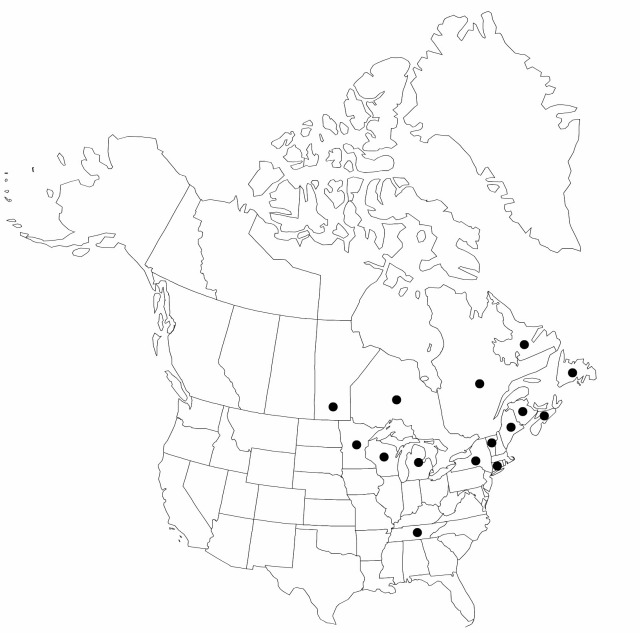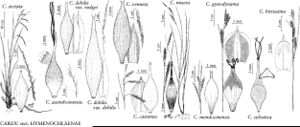Carex castanea
Kongl. Vetensk. Acad. Nya Handl. 24: 155. 1803.
Plants with short rhizomes, loosely cespitose. Culms dark maroon at base; flowering stems 40–90 cm, much longer than leaves at maturity, 0.5–1 mm thick, sparingly pilose. Leaves: basal sheaths maroon, bladeless, pilose; others grading from maroon to green on back, pale to chestnut brown-hyaline and usually red dotted on front, ciliate at apex; blades flat, 2.5–9 mm wide, pilose on both surfaces, sparsely so adaxially, margins smooth or ciliate. Inflorescences: peduncles of lateral spikes capillary, 10–20 mm, glabrous or pubescent; peduncle of terminal spike erect, 3–5 mm; proximal bracts hyaline, reduced to green awn or less often leaflike and 0.3–1.5 mm wide; sheaths usually less than 3 mm (to 10 mm). Lateral spikes 2–4, 1 per node, mostly near apex but not crowded, drooping at maturity, pistillate with 10–40 perigynia attached 1 mm apart, narrowly cylindric, 8–25 × 4–5 mm. Terminal spike staminate, sessile or pedunculate, 10–30 × 1.4–3 (4) mm. Pistillate scales hyaline suffused with chestnut with broad green midrib, ovate, shorter to nearly as long as mature perigynia, apex acute to cuspidate, awns less than 1 mm, often ciliate distally. Perigynia light green, usually red dotted, 2-ribbed and 5–7-veined, at least proximally and abaxially, loosely enveloping achene, ellipsoid, 2.5–5 × 1.3–2.5 mm, membranous, base acute, apex tapering to beak, glabrous; beak bidentate to 1.5 mm, teeth 0.5 mm, ciliate between apical teeth. Achenes substipitate, 1.5–2 × 1–1.5 mm. 2n = 44, 64.
Phenology: Fruiting late spring–mid summer.
Habitat: Cedar swamps, rich mesic deciduous or mixed conifer-hardwood forests, mixed coniferous forests and margins, mesic meadows, often associated with calcareous soils
Distribution

Man., N.B., Nfld. and Labr., N.S., Ont., Que., Conn., Maine, Mich., Minn., N.H., N.Y., Tenn., Vt., Wis.
Discussion
Hybrids between Carex castanea and C. arcata (= C. ×knieskernii) occur quite frequently across the overlapping ranges of the parental species, in roadside ditches near cedar swamps and disturbed areas in deciduous forests, where the two parental species can often be found in close proximity. Carex castanea also hybridizes rarely with C. debilis var. rudgei and probably also with C. gracillima, although the latter hybrid has not been confirmed. The length of the proximal inflorescence bract and its sheath are strongly dependent on location on the culm: If the proximal spike is positioned low on the culm, the blade is leaflike with an obvious but short sheath; if positioned more distally, the blade is reduced to an auriculate awn without a sheath. The chromosome number (2n = 64) reported by Á. Löve & D. Löve (1981b) is probably erroneous.
Selected References
None.
